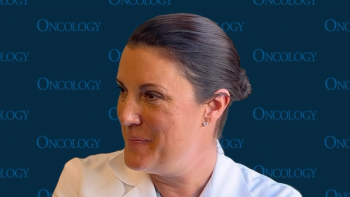
Oncology NEWS International
- Oncology NEWS International Vol 16 No 12
- Volume 16
- Issue 12
CT-related radiation blamed for up to 2% of US cancers
A New England Journal of Medicine review article is highlighting the cancer risks of computed tomography at the same time that hundreds of scientific presentations and new product announcements at the 2007 RSNA meeting are fueling the continued growth of multislice CT.
A New England Journal of Medicine review article is highlighting the cancer risks of computed tomography at the same time that hundreds of scientific presentations and new product announcements at the 2007 RSNA meeting are fueling the continued growth of multislice CT.
David J. Brenner, PhD, DSc, and Eric J. Hall, DPhil, DSc, both associated with the Center for Radiological Research at Columbia University, conclude from an examination of CT physics and often-quoted historical data from survivors of the Hiroshima and Nagasaki atomic bomb blasts that the growth of medical CT utilization may be responsible for 1.5% to 2% of US cancer cases.
They estimate that perhaps 20 million adults and more than 1 million children per year in the United States are irradiated unnecessarily from medical CT (N Engl J Med 357:2277-2284, 2007).
The rapid growth of CT utilizationfrom 3 million procedures in 1980 to 62 million scans per year in the mid-2000sform that basis for Brenner and Hall's concerns. They say the risks for any one person are not large, but the increasing exposure to radiation may be a future public health issue.
Their analysis pegs that growth to the proliferation of multislice CT technology and screening applications for adults and children. They expressed concern about the growing popularity of CT for presurgical diagnosis of appendicitis for children, for example, because diagnostic ultrasound, a modality that involves no ionizing radiation, is probably equally effective for the same procedure.
They cite estimates indicating that 6% to 11% of CT studies are performed on children. A chart in the review indicates that a neonatal abdominal CT exposes a newborn infant to 20 mSv of radiation.
Screening is also an important motivation for increased CT use for asymptomatic adults, according to the authors. They predict that future utilization growth will arise from virtual CT colonoscopy, CT lung cancer screening, cardiac screening, and whole-body screening.
Citing atomic bomb survivor data, Brenner and Hall say that a substantial proportion of the 25,000 survivors received less than 50 mSv exposure, the equivalent of about three cardiac CT scans. A significant increase in the overall risk of cancer was recorded for the subgroup of atomic bomb survivors who received low doses of radiation in the 5 to 50 mSv range, they wrote.
"There is direct evidence from epidemiologic studies that the organ doses corresponding to a common CT study (two or three scans) result in an increased risk of cancer," they wrote. "The evidence is reasonably convincing for adults and very convincing for children."
Part of the issue, they wrote, "is that physicians often view CT studies in the same light as other radiologic procedures, even though radiation doses are typically much higher with CT than with other radiologic procedures."
In a recent survey of radiologist and ER physicians, they said, about 75% of the group significantly underestimated the radiation dose from a CT scan. Further, 53% of the radiologists and 91% of the ER physicians did not believe that CT scans increase the lifetime cancer risk.
In light of these findings, the authors said they welcomed the recent distribution among the medical community of the pamphlet "Radiation Risks and Pediatric Computed Tomography (CT): A Guide for Health Care Providers." The pamphlet can be found on NCI's website: http://www.nci.nih.gov/cancertopics/causes/radiation-risks-pediatric-CT.
The authors recommend better equipment and techniques to lower radiation exposure and the alternative use of MRI and ultrasound, especially for infants and children. They urge physicians to avoid inappropriate CT utilization.
Skepticism from ACR
The American College of Radiology expressed skepticism about the article. In a release, ACR noted that no published research exists to support Brenner and Hall's claim that radiation from CT may cause up to 2% of all cancers in the United States. ACR challenged the correlation between atomic bomb blast data and controlled exposure to radiation involved with CT scanning.
Arl Van Moore, Jr., MD, chair of the ACR board of chancellors, worried that patients may mistakenly avoid what the ACR characterized as "life-saving medical imaging care," because of the article.
"They may be terribly confused and unduly distressed by some of the statements in this study," he said.
Michael Brant-Zawadzki, MD, of RSNA's public information advisor's network, said many radiologists agree that inappropriate CT scans are done because of medico-legal concerns and exploitation by profit-driven referring physicians and commercial imaging providers.
The theoretical risk of carcinogenesis from radiation discussed by Brenner and Hall has been debated for decades. Experts disagree over whether carcinogenesis occurs at the low dose levels generated by CT scanners, Dr. Brant-Zawadzki said.
CT has become the diagnostic workhorse in hospital and emergency room settings and has dramatically increased the diagnostic productivity of physicians, he said. In the ER, CT has replaced the physical exam to speed patient triage.
In contrast to Brenner and Hall's public health concerns about CT, Dr. Brant-Zawadzki stressed its contributions.
"It has saved countless thousands of lives," he said.
Articles in this issue
almost 18 years ago
Third-line single-agent cetuximab ups overall survivalalmost 18 years ago
Modern multislice CT propels pancreas imaging forwardalmost 18 years ago
Sorafenib gets ok for liver canceralmost 18 years ago
Celgene to acquire Pharmionalmost 18 years ago
Novacea halts ASCENT-2 trialalmost 18 years ago
RT/temozolomide raises possibility of cure in glioblastomaalmost 18 years ago
Brachytherapy as effective in younger as in older menalmost 18 years ago
MMA not harming patientsalmost 18 years ago
Kinase inhibitor may prevent RT-induced lung injuryalmost 18 years ago
FDA approves lower starting dose for dasatinib for CMLNewsletter
Stay up to date on recent advances in the multidisciplinary approach to cancer.

















































































